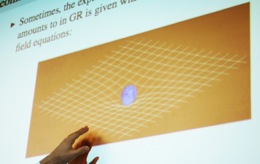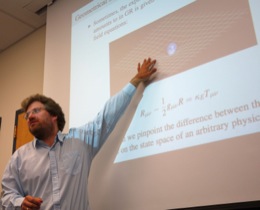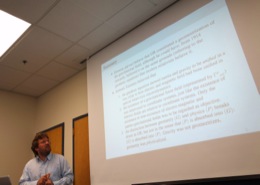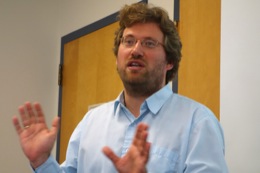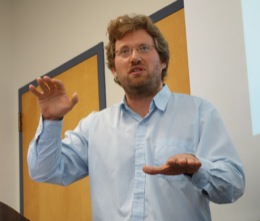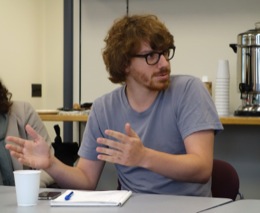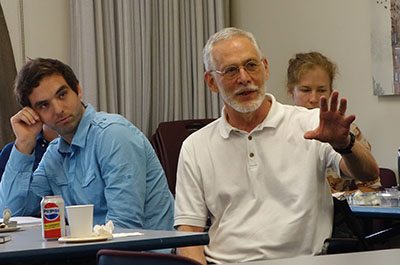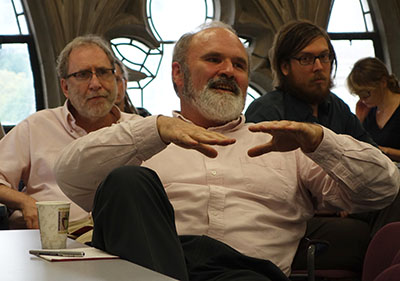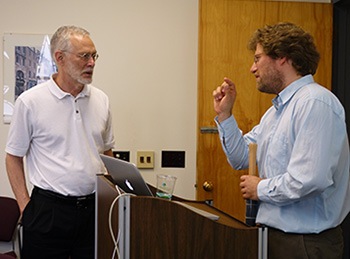

![]()
home
::: about
::: news
::: links
::: giving
::: contact
![]()
events
::: calendar
::: lunchtime
::: annual
lecture series
::: conferences
![]()
people
::: visiting fellows
::: postdoc fellows
::: resident fellows
::: associates
![]()
joining
::: visiting fellowships
::: postdoc fellowships
::: senior fellowships
::: resident fellowships
::: associateships
![]()
being here
::: visiting
::: the last donut
::: photo album
|
Einstein Straightened Out Dennis Lehmkuhl Today's talk is one that I have looked forward to since it was first announced at the beginning of term. It is an Einstein talk. That's my field, or perhaps, just my comfort zone. Dennis Lehmkuhl is spending this year in the Center as a Visiting Fellow. He is especially well qualified to speak on Einstein. Among his many achievements is an appointment as a permanent member of the editorial staff of the Einstein Papers Project at Caltech. That project is the center of the universe of Einstein scholarship. The best new work on Einstein is likely to pass through its doors one way or another. Einstein has come to occupy a central place in modern scholarship. Over fifty years after his death, his achievements are celebrated and interpreted, assessed and reassessed in the light of later discoveries. The effect of this continuing attention has been a slow migration in our understanding of what Einstein did and achieved. That migration may sometimes take us to a view that is almost the exact opposite of what Einstein really said. Elsewhere, I've tried to point out some of the more curious oddities. ("Einstein was Right.") Einstein did not propose dark energy. He disliked his cosmological correction to general relativity so much that he disavowed it over 50 years before dark energy became a lively topic. Einstein was not somehow groping towards the unification string theorists proclaim. He had a visceral aversion to theories like string theory. For they are fundamentally quantum mechanical and seem to favor absolute spacetime backgrounds. Then there's that odd stuff about Einstein and the bees. If there is one thing that we should now have straight about Einstein, it is his greatest achievement, his general theory of relativity. This, we are assured, is where Einstein geometrized gravity. Before Einstein, our theories portray gravity as a force that deflected bodies from their natural inertial motion. The force of gravity from the sun deflects the planets from their natural uniform straight line motions into elliptical orbits. After Einstein, the picture is different. Bodies such as planets in the vicinity of the sun are moving naturally, or inertially. There are no gravitational forces acting on them. But now spacetime is different. It has a geometrical curvature and, when the planets move freely in that curved spacetime geometry, they trace out the familiar elliptical orbits. This notion is commonly represented by a familiar but highly misleading image of a rubber sheet representing space, stretched by a weighty ball representing the sun. Surely we have this much right about Einstein? Dennis' goal today is to show us that we do not. I knew from the abstract that this would be the endpoint of Dennis' talk. He first had some surprising preparatory work to do. Do we really know what it is to "geometrize"? That question caught me off guard. That Einstein geometrized is the common wisdom. But is there some difficulty in saying just what geometrizing is? Now I am willing to believe that Einstein didn't conceive himself as geometrizing. Indeed I'd spent some time elsewhere pondering "How Did Einstein Think?" I have long felt that Einstein was not a geometrical thinker. Here I am speaking about his heuristic methods. That is, Einstein did not use simple geometric pictures now common in spacetime theories as a way of helping him to conceive his theory. Where the geometrical approach is carried out with talk of spaces, lines and surfaces, Einstein dealt with symbols, variables, equations and the forms they took. Geometrical figures and spacetime diagrams are quite rare in his writings. He was an algebraic thinker who thought more about the symbolic form of an equation than the shape of a geometric figure. Thinking geometrically is not the same as geometrizing a theory, I now realized more clearly than before. So what is it to geometrize a theory? The easy answer is that we use a geometric formalism replete with notions of metrical distance and curvature. That doesn't properly characterize geometrizing, Dennis pointed out. We use exactly those notions in modern gauge theories. We have spaces with metrics and curvature, but there is nothing spatial about them in the familiar sense. The spaces span the different electromagnetic field quantities, say, that can live at one point in an ordinary spacetime. It is an internal geometry of electricity and magnetism all living inside just the one point of spacetime. Or is it that gravity is geometrized since gravitational force has been eliminated? What was once gravitational force is now absorbed into the structures that represent the spatial and temporal aspects of spacetime. But does that mean that gravity has been geometrized? Why not say the exact reverse, that spacetime geometry has been physicalized? Quite probably, there is no right answer to this last question. But Einstein's answer, Dennis proceeded to show us, was unequivocal. He now paraded a series of Einstein quotes. They showed that Einstein did not think of what he did with general relativity as geometrizing gravity, but as physicalizing spacetime geometry. Einstein allowed that, if one wanted to think the first way, one might as well say that Maxwell and Hertz geometrized electromagnetism. They built a theory based on the notion of a vector, which is originally a spatial notion. (That origin lingers. We still find it easiest to conceive of a vector as a little arrow in space.) If geometrizing isn't how Einstein thought of his theory, then how did he think of it? This is the extra question that so often gets neglected in these sorts of discussions. We are convinced of what didn't happen. Einstein did not draw much on the Michelson-Morley experiment in his discovery of special relativity, we are so often told. The story stops there and we are left eager to hear more. So if that wasn't it, what was? Dennis proceeded to a detailed account of what Einstein did think he was doing in general relativity. In brief, it was all about unification. In Einstein's special theory of relativity, we learned that the apparently distinct electric and magnetic fields were really just observer dependent manifestations of the one entity, the electromagnetic field. What for one observer might look like a purely magnetic field may manifest for another as a mix of both electric and magnetic fields. It is the same for motion in general relativity. What may appear as motion in a gravitational field for one observer may manifest for another as gravitation-free motion. This was the real import of Einstein's famous elevator thought experiment and his principle of equivalence. Gravity has not been geometrized. It has been relativized. Inertia and gravity are unified in general relativity. Einstein's research trajectory then leads naturally to the focus of his last decades, a unified field theory that would merge gravity with electromagnetism. My sketch here is incomplete; this was a rich talk. Fortunately Dennis has a manuscript in the works that will soon appear in the usual places (e.g. philsci-archive.pitt.edu). I'll encourage you to go there to see the details. We broke for question time and I found myself in an animated conversation with Dennis at the front of the room when it suddenly went quiet. I hadn't been paying attention. It was time for questions. Sitting towards the back of the room, was an eminence grise, John Earman, whose work and thought has molded modern philosophy of space and time more than anyone I know. He had been sitting quietly, absorbing. His patient visage obscured, politely and perfectly, the mischievous firings of neurons behind. What did he think? John began by reassuring Dennis that he had read Einstein correctly. That was fine. But hadn't Einstein just gotten it wrong? Wasn't it the case that general relativity geometrized gravity after all? Gravitational force had gone and in its place was new geometry. This was the seed of discussion that sprouted around the room, in part with help from Kyle. Of course, John allowed, there may be no real distinction between general relativity geometrizing gravity or physicalizing geometry. But still, wasn't Einstein confused? His conventional splitting of motion into an inertial and gravitational part was an illusory effect deriving merely from the choice of spacetime coordinates. There's nothing intrinsic in the geometry of spacetime in it. As all this unfolded, I was watching Dennis. Here were the elements of a good debate. But the wise course for a junior scholar was to listen and absorb. This was not a time to respond with snappy comments that one later regrets.
John D. Norton
|


